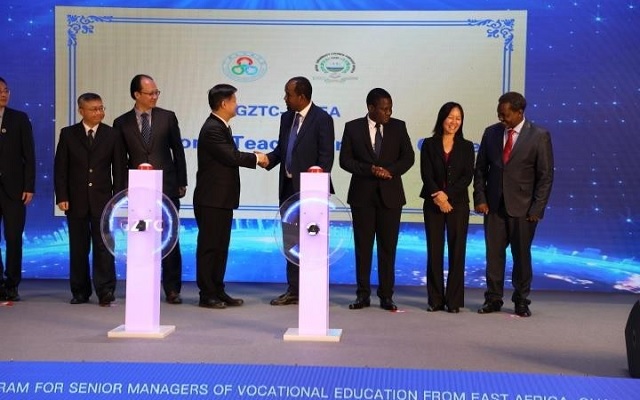
A new type of South-to-South joint program promotes standards through mutually accredited joint programs
COMMENT | XIAOYAN LIANG & COSAM JOSEPH | A common challenge faced by Technical Vocational Education and Training (TVET) institutions is their inability to adapt curriculum and program standards that align with the evolving needs of industries and markets for skills.
African TVET institutes often grapple with outdated curriculum standards and scarcity of resources to acquire modern training facilities that match current technologies. Unfortunately, many development projects do not address occupational standards that underpin various TVET programs or the program delivery standards, which tend to be more theoretical than practical.
Consequently, there is mismatch of skills acquired by graduates from TVET institutes and the skills needed by the real world of work. While some initiatives attempt to address these issues, their staff or curriculum committees often lack industrial and technical experiences and expertise.
The recent collaboration platform introduced by the China-Africa Vocational Education Alliance and the Tanzanian National Council for Technical and Vocational Education and Training (NACTVET) with facilitation from the World Bank, is boldly stepping into this territory to support African TVET systems and institutions in updating occupational and program standards. This initiative aims to bring these standards up to industrial norms and emphasise practical training as well as ensuring systems of knowledge.
Over 70 occupational standards have been updated in fields such as agriculture, energy, construction, transport, aviation, early childhood education, tourism, horticulture, artificial intelligence, and ICT. Aligning and harmonising standards with leading industries can help cultivate relevant skills among students enrolled in TVET institutions. And given the significant presence of Chinese industries in Africa; especially in sectors like construction, transport, renewable energy, ICT, and agriculture, these students will likely have expanded employment opportunities.
The development of TVET program delivery standards is groundbreaking. While some countries have versions of program guides, it is rare to find a comprehensive yet easy to understand guide that clearly stipulates minimum entry, exit, program delivery requirements, and credit distribution among foundational, professional, and industrial practices, certification and qualification. The program delivery standards also recommend corresponding occupations which the graduates are trained for. An interesting observation from the new program delivery standards is that TVET programs have now embed foundational skills in the training in addition to technical skills to ensure that graduates are still trainable and not stuck in dead end qualifications and occupations. Of course, it may still be a long way before the African institutions can amass sufficient human and physical capacity to deliver these programs according to the standards.
Both occupational and program standards undergo scrutiny by the national stakeholders and authorities before nationwide implementation. Certain new standards are being piloted through collaborations between the East Africa Skills for Transformation and Regional Integration Project (EASTRIP) Regional TVET Flagship Institutes (RFTIs) like National Institute of Transport (NIT) and Arusha Technical College (ATC) and their Chinese counterparts. EASTRIP is a five-year project funded by the World Bank and the Governments of Ethiopia, Kenya and Tanzania to increase the access and improve the quality of TVET programs in selected RFTIs and to support regional integration in East Africa.
Following extensive negotiations, Chinese and Tanzanian institutions have agreed to enter into collaborations to offer several joint programs with mutually recognised diplomas. Students are admitted to NIT, ATC, and DIT and receive instructions from both Tanzanian and Chinese teachers. Chinese teachers primarily handle professional core courses, supplemented by industrial attachments, while Tanzanian teachers undergo capacity building from their Chinese counterparts and relevant industries.
Joint programs tend to offer substantial benefits to African institutions, as compliance with stringent requirements in management, faculties, programs, and training facilities required by the overseas counterparts provides strong impetus for institutional improvement. Graduates from these joint programs benefit from more relevant and stringent curriculum and access to the state of the art training environment, including workshop and laboratory facilities, and with the double diploma they often have more opportunities to access quality jobs.
Based on updated occupational and program standards, the design of joint programs for each of the partner institutions, is in response to the demand for highly skilled personnel in the early stages of infrastructure construction and industrialisation in African countries, with the goal of fully exploiting China’s technical advantages on one hand and Africa’s demographic advantages on the other.
This collaboration is bolstered by a trusting partnership between Tanzania and China. Financing is provided by the Chinese government through Chinese TVET colleges, aiming to open up tertiary education in China. Additionally, ongoing World Bank financing through EASTRIP contributes recurrent and capital investments to selected Tanzanian institutions. The collaboration between RFTIs and Chinese TVET institutes is not only limited to Tanzania, but also includes other two participating countries, that is Ethiopia and Kenya.
The potential impact of these joint programs on fundamentally improving TVET capacity in Africa is significant. While there are existing sandwich tertiary programs, such as those in the African Higher Education Centers of Excellence (ACEs) and the PASET Regional Innovation Scholarship Fund (RSIF), most of which are limited to students spending a summer month or one semester conducting research or studying at partner institutions, receiving diplomas only from their home institutions. While such sandwich programs are very beneficial, developing double diploma or degree programs is challenging, as global leading institutions are generally reluctant to accredit programs delivered by institutions in developing countries. In that regard, EASTRIP is again in the forefront of innovations.
As an internationalisation strategy, joint and dual degree programs are welcomed by many academics and policy makers as a natural extension of exchange and mobility programs . Although the international joint and dual program is more prevalent in degree programs particular between North countries, and between North and South countries, they are emerging as a strategy by which institutions can move beyond individual faculty and course-level collaborations to establish ongoing, multidimensional partnerships. While continuous evaluation of these programs is warranted, the new type of South-to-South joint program holds promise bring important benefits to individuals, institutions and national and regional education systems from both sides, result in a more in-depth and reciprocal relationship with the partner institution, as well as a more integrated experience for African students with the support of Chinese enterprises.
****

Dr. Xiaoyan Liang is the Lead Education Specialist at the World Bank and Dr. Cosam Joseph is the Regional Project Coordinator for EASTRIP
The post Africa-China collaboration on TVET appeared first on The Independent Uganda:.




Comments are closed.